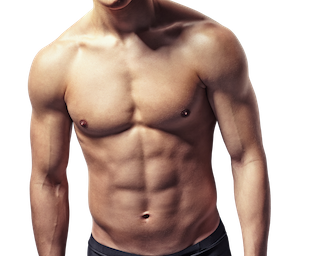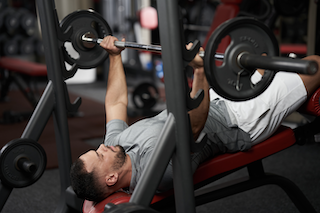Physio Hub:
Evidence-Based Article
Building a Defined Chest Muscles
Evidence-Based Techniques for Success

< Key Points >
- Understanding the Anatomy of the Chest, specifically the upper (clavicular head) and lower (sternal head) muscles, is essential for targeted and effective chest development.
- Effective Upper Chest Development requires inclined bench presses and dumbbell exercises, while Lower Chest Growth benefits from close grip bench presses and specific stretching for flexibility and muscle definition.
- A Strategic Combination of Strength Training and Stretching, informed by chest anatomy and research-proven exercises, is key to achieving a well-defined, aesthetically pleasing, and functional chest.
Did you know that building a defined chest is not just about lifting heavy weights? It’s a complex interplay of exercise selection, anatomical understanding, and proper technique. For those looking to enhance their chest muscles, the journey begins with evidence-based strategies that target both the upper and lower portions of the chest. Let’s delve into how to sculpt a balanced and aesthetically pleasing chest.
Understanding the Anatomy
To effectively develop any muscle group, it’s essential to first grasp the underlying anatomy. The primary muscle of the chest, known as the pectoralis major, is divided into two sections: the clavicular head (upper chest) and the sternal head (lower chest). Targeting both sections is crucial for optimal development, as this approach not only aids in muscle size but also improves definition and symmetry. Research highlights that a well-rounded training program that addresses both areas promotes a more functional and visually appealing chest (Melani, 2019).
Exercises for Upper Chest
When it comes to focusing on the upper chest, the inclined bench press stands out as a top choice. Studies indicate that performing this exercise at a 30° incline effectively activates the upper pectoralis major (Rodríguez-Ridao, 2020). Another great addition to your routine is the dumbbell fly. This exercise not only isolates the upper chest but also allows for an extended range of motion, which is vital for muscle development. Correct technique is paramount in these movements to ensure maximum muscle activation and minimize the risk of injury (Welsch, 2005).
Exercises for Lower Chest
For targeting the lower chest, the traditional flat bench press reigns supreme, providing optimal activation of the sternal portion. However, the decline bench press also plays a significant role by specifically targeting the lower pectoralis (López-Vivancos et al., 2023; Glass & Armstrong, 1997). Incorporating both variations into your training regimen can help create a balanced chest appearance and prevent any imbalances that may arise from focusing solely on the upper or lower sections.
Additional Strategies for a Defined Chest:
Building muscle isn’t just about lifting weights. To achieve a defined chest, incorporating mobility work into your routine is essential. Research shows that shoulder horizontal abduction stretching, especially at angles of 90° and 150°, enhances the flexibility of the pectoralis minor muscle through a mechanism known as the shear elastic modulus (Umehara, 2017). Furthermore, unilateral self-stretching is highly effective for elongating this muscle, leading to improved flexibility and a more defined chest (Borstad JD, 2006). These stretches complement your strength training, contributing to a more symmetrical and complete chest appearance.
Wrapping Up: Your Path to a Bigger, Defined Chest
Building a defined chest is a multifaceted process that requires a strategic combination of understanding anatomy, selecting the right exercises, and incorporating flexibility work into your routine. By focusing on both the upper and lower portions of the pectoralis major, you can sculpt a well-defined, balanced chest that not only looks great but functions effectively. So gear up, stay consistent, and enjoy the journey of transforming your chest into a strong and aesthetically pleasing aspect of your physique. Embrace these evidence-based approaches, and you’ll be well on your way to achieving your strength and aesthetic goals.
< Recommendation by Our Experts>
-
Implement Incline Bench Press and Dumbbell Flies for Upper Chest: Regularly incorporate incline bench presses at a 30° angle and dumbbell flies into your routine to specifically target and enhance the upper chest’s size and definition.
-
Include Pec Stretches: Add shoulder horizontal abduction stretches at 90° and 150° to your workouts to increase the mobility and flexibility of the pectoralis minor, which can contribute to a more defined and symmetrical chest.
-
Adjust Bench Angles for Lower Chest: Use close grip bench presses and adjust the bench to a slight decline to effectively isolate and strengthen the lower pectoralis major, ensuring balanced growth across the entire chest area.
< Reference >
- Melani A, Gobbi G, Galli D, et al. Muscle Activation in Traditional and Experimental Barbell Bench Press Exercise: A Potential New Tool for Fitness Maintenance. Sports. 2019;7(10):224. doi:10.3390/sports7100224
- Rodríguez-Ridao D, Antequera-Vique JA, Martín-Fuentes I, Muyor JM. Effect of Five Bench Inclinations on the Electromyographic Activity of the Pectoralis Major, Anterior Deltoid, and Triceps Brachii during the Bench Press Exercise. IJERPH. 2020;17(19):7339. doi:3390/ijerph17197339
- Welsch EA, Bird M, Mayhew JL. Electromyographic Activity of the Pectoralis Major and Anterior Deltoid Muscles During Three Upper-Body Lifts. J Strength Cond Res. 2005;19(2):449. doi:1519/14513.1
- López-Vivancos A, González-Gálvez N, Orquín-Castrillón FJ, Vale RGDS, Marcos-Pardo PJ. Electromyographic Activity of the Pectoralis Major Muscle during Traditional Bench Press and Other Variants of Pectoral Exercises: A Systematic Review and Meta-Analysis. Applied Sciences. 2023;13(8):5203. doi:3390/app13085203
- Glass SC, Armstrong T. Electromyographical Activity of the Pectoralis Muscle During Incline and Decline Bench Presses. J Strength Cond Res. 1997;11(3):163. doi:1519/1533-4287(1997)011<0163:EAOTPM>2.3.CO;2
- Umehara J, Nakamura M, Fujita K, et al. Shoulder horizontal abduction stretching effectively increases shear elastic modulus of pectoralis minor muscle. Journal of Shoulder and Elbow Surgery. 2017;26(7):1159-1165. doi:1016/j.jse.2016.12.074
- Borstad JD, Ludewig PM. Comparison of three stretches for the pectoralis minor muscle. Journal of Shoulder and Elbow Surgery. 2006;15(3):324-330. doi:1016/j.jse.2005.08.011




